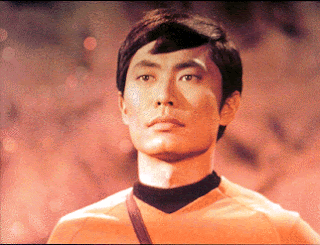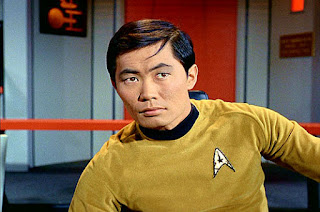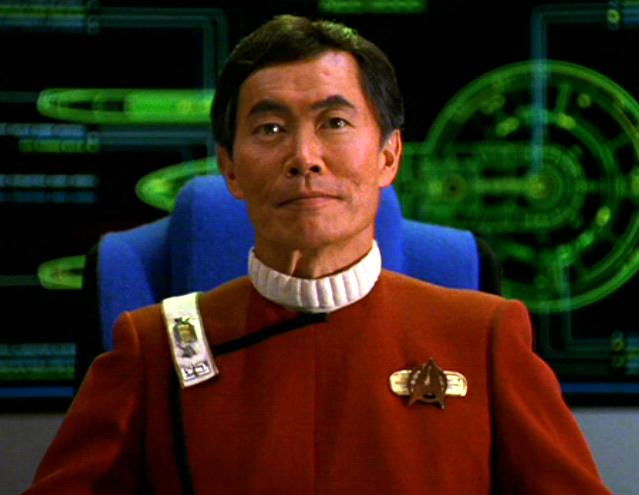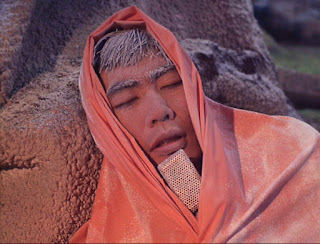It's hard to have a conversation about Asian-American characters in pop culture without talking about Hikaru Sulu. While not technically the first Asian-American man to appear as a regular on a US prime-time network show, Sulu's inclusion in the original Star Trek series was a giant leap for representation. It showed us a vision of the future that included people from all different races and backgrounds working together in peace, harmony, and good humor. It showed us a world where an Asian man wasn't just some background character, but an integral figure on the show and a competent crewmember eventually promoted to Captain of his own vessel.
You can't talk about this history of Asian-American representation without talking about Sulu.
But there's a reason we saved him for last, rather than kicking things off with the grandfather of sci-fi diversity. See, it's easy to talk about the massive impact that a single character can have on a whole genre of representation, but it's much more telling to be able to lay the whole thing out after the fact. The truth of the matter is, all roads lead to Sulu.
The first thing we talked about this month (for Masculinity Monday, that is) was Harold and Kumar Go to White Castle, a stoner comedy starring two Asian-American characters and openly rebutting the idea that Asian-American men are inherently "hardworking" and "submissive". This movie is in a lot of ways an expansion of the ideas put forth by Sulu's inclusion in Star Trek.
 While Sulu is, admittedly, an incredibly hardworking and dedicated crewmember, that's not considered a distinctive characteristic of his. He actually has lots of other traits and memorable qualities: his dedication to his job is no different than anyone else's. In addition, Sulu on the original Star Trek was allowed to be a hot ladies' man - I mean, I certainly remember the shirtless episode, don't you? These factors started a rebuttal of the idea that Asian-American men were inherently weak or fragile and more willing to work like drones, ideas that Harold and Kumar smashed into the ground forty years later.
While Sulu is, admittedly, an incredibly hardworking and dedicated crewmember, that's not considered a distinctive characteristic of his. He actually has lots of other traits and memorable qualities: his dedication to his job is no different than anyone else's. In addition, Sulu on the original Star Trek was allowed to be a hot ladies' man - I mean, I certainly remember the shirtless episode, don't you? These factors started a rebuttal of the idea that Asian-American men were inherently weak or fragile and more willing to work like drones, ideas that Harold and Kumar smashed into the ground forty years later.Also it's worth mentioning that John Cho, who got his start in Harold and Kumar, went on to play Hikaru Sulu in the new Star Trek reboot. Just saying.
Next we looked at the phenomenon of the "Stealth Asian", or cases where Asian-American actors have been pushed into playing characters who pass as white, most specifically examining Bellamy Blake on The 100 and how his character might as well be white. One of the big reasons this topic is so important to discuss is because we know, because of Sulu, the importance of actual diverse representation. By looking at the legacy that one prominent character of color can have on an entire genre and culture, we can then extrapolate the cost of depriving us of other prominent characters of color.
In other words, without Sulu, the whole "Stealth Asian" thing might not seem so bad, but when you have an example of positive diverse representation dating back to 1966, you don't really have an excuse for not doing better. Especially in a science-fiction show like The 100 that, like Star Trek, supposedly takes place in a "post-racial" society. Come on, guys.
In our third week of Asian-American and Pacific Islander Heritage Month, we swerved a little and examined the hilarious and infuriating Tom Haverford from Parks and Recreation in order to talk about the immigrant experience and what it means now for Asian-Americans to "chase the American dream". This is an important discussion to have, but it also links in again with what our conceptions of the American dream are and ought to be. Sulu might live in a futuristic utopia, but isn't that an American dream as well? By examining the world as it is and what we want from it, we open the possibility of being able to create a world where Hikaru Sulu can exist and captain a ship for the Federation. And I'm all in favor of that.
Finally, last week we talked about patriotism and what it means to serve a country that doesn't serve you by looking at Captain America's Jim Morita, a Japanese-American soldier in World War II who served in Europe while his family was presumably locked in internment camps in California. This one was the hardest to write and arguably the most poignant, because it calls to mind a horrible period of American history, the kind of thing we'd much rather forget and pretend never happened, but exactly what we need to acknowledge and remember if we're going to be the nation we always say we are.
More importantly, there's a very direct throughline from Jim Morita's experiences in the American internment camps and trenches of WWII to Sulu's existence in Star Trek, and that throughline takes the form of George Takei himself, the actor who played Sulu. Takei, who was born in 1937, was only five years old when his family was forced out of their Los Angeles home and into a series of internment camps in the Southwest. We must assume that he brought this memory and awareness of American cruelty with him as he created the character of Sulu.
So what does all of this mean? If we've been talking around Sulu this whole time, what is left to say about him? Oh don't worry, there's still plenty.
In 1966 it wasn't exactly a common idea to have a major character on your show who was a Japanese-American man, but Gene Roddenberry's idea of a utopian future included no racial discrimination, so he approached George Takei and offered him a space in the program. Roddenberry's goal with the character was a create a "pan-Asian" character, the sort of character who could stand in for all of Asia and show that in the future the conflicts of the present would be but a dark history.
While the character, then, is technically Japanese-American, his name is taken from the Sulu Sea, a body of water that touches a lot of different parts of Asia all at once.* Sulu was always intended to be a character who showed the very best of who humans could be, and he does.
Seriously, Hikaru Sulu is a wonderful man. Kindhearted and a good friend, Sulu is the sort of well-rounded and interesting character we feel lucky to get today, let alone in the 1960s. He loves 19th century adventure novels, enjoys fencing and gymnastics, and at one point gets mind-whammied by some poison and thinks he's the swashbuckling hero D'Artagnan from The Three Musketeers. Sulu likes botany - he has a really complex plant that requires a lot of care - enjoys chess pretty well, and generally is the kind of guy you'd be happy to spend five years in space with.
He's also a respected and competent crewman, the officer most trusted to take the helm and command the bridge when neither Kirk nor Spock are present. Sulu is, in fact, in charge of the ship during a number of stressful and intense incidents, and he handles all of them well. He's damn good at his job and he definitely doesn't apologize for that.
More than all of this, though, Sulu is emotional without being weepy. He's masculine without being macho. And he's sexual without being sexualized. In all of these and even more ways, Sulu is a walking refutation of the stereotypes that plagued the Asian-American community of the mid-century and a lot of the tropes that plague them today.
Arguably most importantly, Sulu's inclusion on the command deck of the USS Enterprise was a huge step for the idea of Asian-American future. By putting Sulu front and center and vital in the Enterprise's bridge, Star Trek created a vision of the future where Asian-Americans were not just present but crucial.
A future where there were no barriers based on race, where a boy who looked like Sulu could grow up to be the captain of a spaceship. A future where no one would call him racist slurs, where no one would demean his masculinity, where he could be whatever he aspired to be.
 We've talked before about the ability of fiction to create reality. Mae Jemison, the first African-American woman in space, openly cited Star Trek's Uhura as the character who inspired her to even try to become an astronaut. Making Sulu part of Star Trek didn't just create some warm fuzzies for the Asian-American community, it had a big impact on our cultural conception of Asian-American identity in the here and now. We're still feeling those reverberations today, and that's why Sulu is so important.
We've talked before about the ability of fiction to create reality. Mae Jemison, the first African-American woman in space, openly cited Star Trek's Uhura as the character who inspired her to even try to become an astronaut. Making Sulu part of Star Trek didn't just create some warm fuzzies for the Asian-American community, it had a big impact on our cultural conception of Asian-American identity in the here and now. We're still feeling those reverberations today, and that's why Sulu is so important. It's also, however, why we need to move past him.
Look, Captain Hikaru Sulu is amazing and I love him, but he first appeared on our televisions fifty years ago. Literally. It has been fifty years since Sulu first swashbuckled his way into our hearts, and in a very real sense, we haven't moved past him as a representation of Asian-American masculinity.
I mean, yeah, there have been some small inchings along the road of progressiveness, but nothing substantive. He's still the go-to guy. He's the character we all think of, the icon. And that's not good, because we should have a lot of icons by now. We should have a whole host of Sulus to look up to, not just the one.
So it's time to get our butts in gear. Asian-American representation, particularly representation of Asian-American men, lags so far behind representation of white men as to be statistically insignificant. Asian-American men are still beset by stereotypes about weakness and lack of sexual appeal and being worker drones. We need better, and that means that we need to demand better. Hollywood is, as you might have guessed by now, adverse to change in the extreme. We have to make a noise if we want to be heard. We have to make them listen.
How do we do that? Well, as much as it pains me to admit it, the first and easiest way is to use capitalism against them. Support projects with Asian-American leads. Go see movies about Asian-American characters in the movie theater and pay full ticket price. Praise those movies on twitter. Don't shut up. Be obnoxious. Keep doing it. And don't go see movies that whitewash out Asian characters, even if they're the big movies of the summer. Stick to your guns, and put your money where your mouth is.
Talk about Asian-American movies and television shows and books and comics and don't let anyone stop talking about them. Force the issue. Highlight what you love, decry what you don't. In other words, speak up! Asian-American Heritage Month might be over for this year, but that doesn't mean it's time to be quiet.
Sulu is an amazing character, a hero who I totally looked up to as a little kid. But he shouldn't be the only iconic Asian-American character we can name. He should be one of many, and if Hollywood isn't going to give that to us, we're going to have to make them. I like to think Sulu would approve.
 |
| #friendship goals |





While the character, then, is technically Japanese-American, his name is taken from the Sulu Sea, a body of water that touches a lot of different parts of Asia all at once.
ReplyDeleteWhen JJ Abrams was casting the reboot, he asked George Takei for permission to cast John Cho, given that Cho was Korean, and Takei cited this very point as the reason why he was ok with it.
https://gunshipbattlemod.xyz/apk/ https://templerun2mod.info/apk/ https://mobilelegendsmod.info/apk/
ReplyDeletekolkata call girls center
ReplyDeleteindependent call girls in kolkata
kolkata call girls number
call girls naked picture picture kolkata
kolkata call girls home service
kolkata call girls in hotel room porn
kolkata call girls in night street
kolkata call girls mobile number and rate
kolkata call girls number
call girl near me
kolkata call girls personal contact no
kolkata call girls sex videos
CALLL GIRL kolkata
ReplyDeleteFEMALE CALL GIRLS KOLKATA
FEMALE CALL GIRLS
SEXY CALL GIRLS SERVICE IN KOLKATA
ESCORTS SERVICE IN KOLKATA
KOLKATA FEMALE ESCORT SERVICE
TOP ESCORTS SERVICE KOLKATA
BEST KOLKATA ESCORTS SERVICE
CALL GIRLS SERVICE
ESCORTS SERVICE
ESCORT SERVICE
ESCORTS SERVICE IN KOLKATA
BENGOLI ESCORTS GIRLS
BENGOLI CALL GIRLS KOLKATA
KOLKATA ESCORTS SERVICE
FREE ESCORTS SERVICE KOLKATA
FREE WHATSAAP NUMBER ESCORTS
FREE WHATSAAP NUMBER OF CALL GIRLS
PHONE NUMBER OF ESCORTS SERVICE
FREE PHONE NUMBER ESCORTS SERVICE
MOBILE NUMBER OF ESCORTS SERVICE
เล่นสล็อต xo เกมสล็อตออนไลน์แจกฟรีเครดิต slotxo ลองได้ไม่เสียเงิน
ReplyDeletehttps://www.slotxd.com/slotxo
ReplyDeleteEvery day asks for our best. Every day we sit poised to uplift and deliver, or stumble and sink.
Connexus Academy Login
Ines De Ramon
RASMUSSEN STUDENT PORTAL
content://com.android.browser.home/
It has fully emerged to crown Singapore's southern shores and undoubtedly placed her on the global map of residential landmarks. I still scored the more points than I ever have in a season for GS. I think you would be hard pressed to find somebody with the same consistency I have had over the years so I am happy with that. 먹튀검증
ReplyDelete